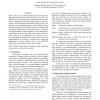Free Online Productivity Tools
i2Speak
i2Symbol
i2OCR
iTex2Img
iWeb2Print
iWeb2Shot
i2Type
iPdf2Split
iPdf2Merge
i2Bopomofo
i2Arabic
i2Style
i2Image
i2PDF
iLatex2Rtf
Sci2ools
SIGMETRICS
1991
ACM
1991
ACM
Implementing Stack Simulation for Highly-Associative Memories
Prior to this work, all implementations of stack simulation [MGS70] required more than linear time to process an address trace. In particular these implementations are often slow for highly-associative memories and traces with poor locality, as can be found in simulations of file systems. We describe a new implementation of stack simulation where the referenced block and its stack distance are found using a hash table rather than by traversing the stack. The key to this implementation is that designers are rarely interested in a continuum of memory sizes, but instead desire metrics for only a discrete set of alternatives (e.g., powers of two). Our experimental evaluation shows the run-time of the new implementation to be linear in address trace length and independent of trace locality. Kim, et al., [KHW91] present the results of this research in more detail. KEY WORDS: trace-driven simulation, stack simulation, caches, memory systems, file systems.
Related Content
| Added | 27 Aug 2010 |
| Updated | 27 Aug 2010 |
| Type | Conference |
| Year | 1991 |
| Where | SIGMETRICS |
| Authors | Yul H. Kim, Mark D. Hill, David A. Wood |
Comments (0)

